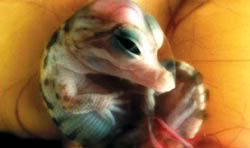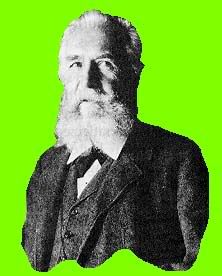
Last night, I saw history made. In the 19th century, the entire length of a giraffe's vagus nerve was dissected out for the first time. Now, for the first time on film, the entire length of the giraffe's recurrent laryngeal nerve (which goes down the length of the neck and part of which joines the vagus nerve, which then goes right on down to the abdomen before returning) has been dissected out - by Dr Joy Reidenberg, as part of the last episode of Inside Nature's Giants. In each of four instalments we saw, in the words of Professor Alun Williams of the Royal Veterinary College, "the post mortem of large wild animals – an opportunity that doesn’t very often happen even in the life of a vet."

Vagus is Latin for "wandering", and in humans alone it's easy to see why the nerve is so named, as it meanders more than Leopold Bloom - originating in the brain, passing into the neck and going past the voicebox, thence through the chest to the abdomen. In the giraffe, the thing's more redolent of Odysseus, going down the entire length of the neck before returning.
A comparative anatomist and Associate Professor at the Mount Sinai School of Medicine, from where she received the Outstanding Doctoral Dissertation Award among many others (as well as, for example, from the American Association of Anatomists and Society for Marine Mammalogy), she reacted with dignity when Richard Dawkins, behind her, counselled her to be careful not to cut the nerve at a crucial point in its dissection.
Preofessor Dawkins has appeared in short slots throughout the series, although I was surprised that he only popped up twice in last week's programme, during which a crocodile which had died unexpectedly was dissected.
 The reason I was surprised at this was because, to explain why the crocodile has two aortas the team took us through its embryological development. Other embryos lose one or other aortic arches during development, but crocodiles retain both so that when necessary the "extra" one can carry deoxygenated blood, which has a lower pH, to the stomach to help manufacture the amounts of acid necessary to begin digestion of large chunks of meat.
The reason I was surprised at this was because, to explain why the crocodile has two aortas the team took us through its embryological development. Other embryos lose one or other aortic arches during development, but crocodiles retain both so that when necessary the "extra" one can carry deoxygenated blood, which has a lower pH, to the stomach to help manufacture the amounts of acid necessary to begin digestion of large chunks of meat.I would've expected more input on this from the author of books like The Selfish Gene and The Extended Phenotype, because for somebody who believes that bodies are vehicles for genes travelling through the ages like a great river (the concept behind 1995's River out of Eden), the game's just about over by the time of birth, for vertebrates at least. All that's then necessary is surviving long enough for the purposes of "finding at least one heterosexual partner and successfully copulating" (in Dawkins' words in the aforementioned work); and for humans, he adds in The God Delusion, sticking together until the offspring reach adolescence.
 There's a lot of theorising about embryos that is frankly strange - for example, that represented by the phrase "ontogeny recapitulates phylogeny" coined by Ernst Haeckel in 1866, seven years after Darwin published his first edition of The Origin of Species. This was the theory that an embryo recalled in its form the stages through which life had evolved to give rise to that particular species. There's debate about whether the famous drawing, of which the last section is reproduced below, can be traced back to Haeckel, and I realise that some biologists are returning to the theory, albeit with major qualifications - for example with observations that human embryos have develop, for very short periods, structures resembling a yolk sac and gill slits.
There's a lot of theorising about embryos that is frankly strange - for example, that represented by the phrase "ontogeny recapitulates phylogeny" coined by Ernst Haeckel in 1866, seven years after Darwin published his first edition of The Origin of Species. This was the theory that an embryo recalled in its form the stages through which life had evolved to give rise to that particular species. There's debate about whether the famous drawing, of which the last section is reproduced below, can be traced back to Haeckel, and I realise that some biologists are returning to the theory, albeit with major qualifications - for example with observations that human embryos have develop, for very short periods, structures resembling a yolk sac and gill slits. 
Not only did Dawkins not mention embryology, but you can imagine my surprise when I read in River Out of Eden:
after numerous foldings-in, pushings-out, bulgings and stretchings of layers of cells...when the total number of cells has reached into the trillions, the final product is a baby. No, even the baby is not final, because the whole growth of the individual - again, with some parts growing faster than others - past adulthood into old age should be seen as an extension of the same process of embryology: total embryology.I wouldn't like to present Dawkins as a pro-lifer, and his statement that the moral case for selective abortion will become overwhelming doesn't endear me, as a person living with a disability that tends to run through families, to him; but his statement above still seems to anticipate and turn on it's head that of John Harris, Professor of Bioethics at Manchester University, making the case for euthanasia for newborn babies:
We can terminate for serious foetal abnormality up to term but cannot kill a newborn. What do people think has happened in the passage down the birth canal to make it okay to kill the foetus at one end of the birth canal but not at the other?Something that made me sit up during the giraffe autopsy was when Graham Mitchell of the University of Wyoming - described by narrator Mark Evans as "the giraffe expert" - commented that the piston-like system of inflating the huge creature's lungs to make running possible "couldn't have been better designed"; there was a polite laugh from the audience of veterinary students when he corrected himself "...evolved". It might have been a simple case of coming out with the wrong word, but the hasty correction reminded me of a phrase from the introduction to the 1996 edition of Dawkins' The Blind Watchmaker: "I was reminded of the creationist student who, through some accident of the selection procedure, was once admitted to the Zoology Department at Oxford University".
"That's not intelligent design", Reidenberg remarked of the giraffe's vagus nerve, and I would have found it difficult to disagree. Nor would I have wanted to - I don't predicate intelligence of evolution any more than I do, say, of heat as it boils water, or - more importantly - of yeast as it turns malt and hops into beer. I attribute intelligence, rather, to the person who starts off the process with a specific end in mind. In the case of the kettle or the brewery, the end is a cup of tea or a pint in the Tintinnabula with Professor Calculus.
In that of Creation, I believe God created the universe aeons ago so that it would unfold in a certain way, and is continually present to nurture us if we choose to use our free will to take advantage of that. I realise many will disagree with me - not least some of my co-religionists - but being able to communicate with each other and thereby develop and learn is one of the great things about living in a society in which, at the time of writing, we are free.

Related posts: elephants, arthritis and euthanasia: Inside Nature's Giants
Whales and unintelligent evolution: Inside Nature's Giants
Click here to go to the Channel 4 website for Inside Nature's Giants











Hi there! Thanks for visiting my blog. I have spent some time perusing your blog and well, what can I say? LOTS of interesting reading and I so far like what I see :)
ReplyDeleteI am pro-life not pro-death.
I believe in intelligent design. Blogs for example don't randomly happen when a keyboard collides with fingers and electricity.
I am an Israeli Jewess. I appreciate the things you have posted in that regard. Thank you for pointing out the things done to Christians in the name of the Quran.
The following statistics are supplied by Ynet News:
According to the Central Bureau of Statistics, there were some 57,000 Christian households in 2008, representing 3% of total households in Israel. Christian families have an average of 3.4 family members, slightly higher than in Jewish households (3.1) and lower than Muslim households (5). Since 1992, the number of family members in the Christian household has decreased from 4.2 to 3.4. One of the contributing factors was the immigration wave from the Former Soviet Union during the 1990s, which was characterized by relatively small households. The Christian population growth rate at the end of 2008 stood at 1%, compared with 1.7% growth rate in the Jewish population and 2.8% in the Muslim population. During the same year, Christian women gave birth to 2,511 children, 81% of which belonged to the Arab sector. The birth rate among Christian women has decreased over 50% since the 1960s. In 1960, the average birthrate was 4.6 children, whereas today it is two. – the lowest birth rate among the different religious groups in Israel.
Sorry for bombarding your comment box.
xx
D
Hi D,
ReplyDeletedon't apologise - thank you so much for your comments about my blog!
Antisemitism angers me immeasurably, both in itself and as part of the creeping islamicisation of Great Britain and the West in general; part, I think, of the leftward drift of society over the last decade or so.
It was great to meet you over at Linda's blog, I find her take on life as refreshing as the sweetest water in a drought because, despite the slings and arrows of outrageous fortune, she lives the pro-life ideal - I imagine you're something the same.
I found your stats on Christians in Israel very interesting - I might use them sometime!
I have some Jewish bloggers on my blogroll to the right. You may know of them, but if you don't have a browse!
A bientôt!
My business partners required a form last month and were informed about a business with lots of form templates . If you have been needing it too , here's http://pdf.ac/15VfxU
ReplyDelete